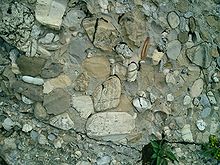
Molasse

In geology, "molasse" (/məˈlæs/) are sandstones, shales and conglomerates that form as terrestrial or shallow marine deposits in front of rising mountain chains. The molasse deposits accumulate in a foreland basin, especially on top of flysch-like deposits, for example, those that left from the rising Alps, or erosion in the Himalaya. These deposits are typically the non-marine alluvial and fluvial sediments of lowlands, as compared to deep-water flysch sediments. Sedimentation stops when the orogeny stops, or when the mountains have eroded flat.[1]

The molasse can sometimes completely fill a foreland basin, creating a nearly flat depositional surface, that nonetheless remains a structural syncline. Molasse can be very thick near the mountain front, but usually thins out towards the interior of a craton; such massive, convex accumulations of sediment are known as clastic wedges.[1]

See also
- Geology of the Himalaya – Origins and structure of the mountain range
- Molasse basin – Foreland basin north of the Alps
References
- ^ a b Stanley, Steven M., Earth System History, New York: W.H. Freeman and Company, 1999, p.243 ISBN 0-7167-2882-6
Further reading
- Sinclair, H. D. (1997) "Flysch to molasse transition in peripheral foreland basins: the role of the passive margin versus slab breakoff" Geology 25(12): pp. 1123–1126, doi: 10.1130/0091-7613(1997)025<1123:FTMTIP>2.3.CO;2
- Tenchov, Yanaki G. (1989) "Demarcation of Molasse from Non-molasse sediments" Zeitschrift für geologische Wissenschaften 17(8): pp. 791–796
External links
- http://www.see.leeds.ac.uk/structure/alps/map/molasse.htm Molasse, definitions and examples, simplified geological map of the western Alps. University of Leeds

See what we do next...
OR
By submitting your email or phone number, you're giving mschf permission to send you email and/or recurring marketing texts. Data rates may apply. Text stop to cancel, help for help.
Success: You're subscribed now !
